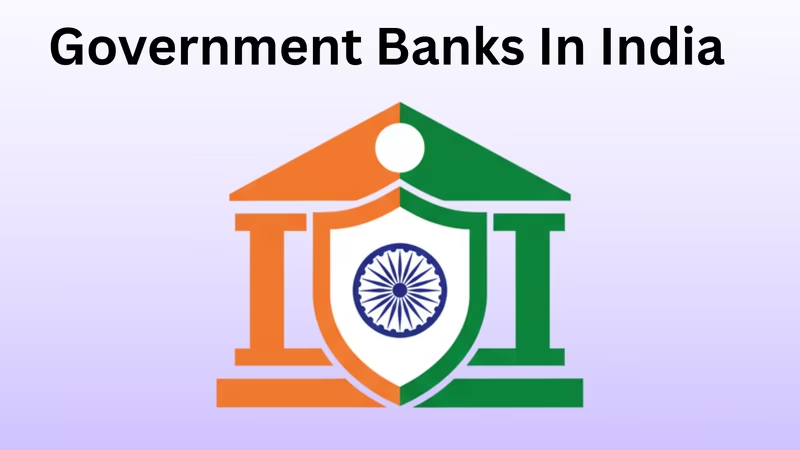Ever had that moment of doubt when choosing a bank? With so many options, where do you put your hard earned money for real, long term safety?
For millions of Indians, the answer is simple: a "sarkari bank."
When you think of trust and banking in India, it’s almost always the familiar logo of a government bank in India that comes to mind.
These are the banks our parents and grandparents have trusted for decades. But who are they, really? And in this age of digital-first banking, do they still matter?
They absolutely do. Let’s dive into the world of public sector banks in India and find out why they are the financial backbone of our nation.
What makes Public Sector Banks (PSU Banks) so significant?
First off, you’ll hear a lot of terms: PSU banks in India, government banks and nationalized banks in India. What’s the difference?
Honestly, for you and me, they are used to mean the same thing.
A Public Sector Bank (PSU) is simply a bank where the majority stake (more than 50%) is held by the Government of India. The government is the boss. This is why they are called "government banks."
These banks are not just private companies; they are financial institutions with a national agenda.
They are overseen by the Ministry of Finance and regulated by the big boss of all banks, the Reserve Bank of India (RBI).
This government backing is their superpower. It gives them a level of stability and public trust that is incredibly hard to beat.
Why Do People Still Choose Nationalised Banks in India?
This is a question many people are searching for. In a world of flashy neobanks and slick apps, why stick with a nationalised bank in India?
- Unbeatable Trust: This is the big one. The government's majority stake acts as a safety net. People feel that their money is safest here.
- Unmatched Reach: From the busiest metro city to the most remote village, you will find a branch or an ATM of a government bank. They are built for financial inclusion, not just for profit.
- Customer Focused: These banks are designed to serve every single citizen. They handle everything from a simple farmer's Kisan credit card to massive government infrastructure loans and employee pension accounts.
- Stability Over Fads: PSU banks are not known for chasing risky trends. They are built like solid, dependable elephants slow, steady, and incredibly powerful.
After a series of big mergers, India now has 12 nationalized public sector banks. Let's get to know them.
Top Public Sector Bank In India
| Bank Name | Headquarters | A Quick Fact / Tagline |
| State Bank of India (SBI) | Mumbai, Maharashtra | "The Banker to Every Indian" (India's largest bank) |
| Punjab National Bank (PNB) | New Delhi | "The Name You Can Bank Upon" (One of India's oldest) |
| Bank of Baroda (BoB) | Vadodara, Gujarat | "India's International Bank" |
| Canara Bank | Bengaluru, Karnataka | "Together We Can" |
| Union Bank of India | Mumbai, Maharashtra | "Good People to Bank with" |
| Bank of India (BoI) | Mumbai, Maharashtra | "Relationship Beyond Banking" |
| Indian Bank | Chennai, Tamil Nadu | "Your Own Bank" |
| Central Bank of India | Mumbai, Maharashtra | "Central to You Since 1911" |
| Indian Overseas Bank (IOB) | Chennai, Tamil Nadu | "Good People to Grow With" |
| UCO Bank | Kolkata, West Bengal | "Honours Your Trust" |
| Bank of Maharashtra | Pune, Maharashtra | "One Family, One Bank" (Lokmangal) |
| Punjab & Sind Bank | New Delhi | "Where Service is a Way of Life" |
Uncover which private bank rules 2025 and why it’s winning every customer’s trust.
1. State Bank of India (SBI)
- Headquarters: Mumbai, Maharashtra
You just can't talk about government banks in India without starting here. SBI is the elephant in the room in the best way possible.
It is the largest public sector bank in India by a massive margin. Its history goes back over 200 years to the Bank of Calcutta in 1806.
If you need a bank that is literally everywhere, from a tiny hamlet in Ladakh to a branch in New York, SBI is your answer.
2. Punjab national bank (PNB)
- Headquarters: New delhi
PNB is one of the oldest banks on this list, with a history steeped in the Swadeshi movement.
It was founded in 1894 in Lahore by visionaries like Lala Lajpat Rai, making it the first bank purely managed by Indians.
After a major merger with the Oriental Bank of Commerce (OBC) and United Bank of India, PNB has become the second-largest PSU bank in India, with an incredible network, especially in the northern states.
3. Bank of Baroda (BoB)
- Headquarters: Vadodara, Gujarat
Just like its tagline says, Bank of Baroda is India's most outward-looking bank, with a significant global presence in over 20 countries.
This makes it a popular choice for NRIs and businesses dealing in international trade.
It became a huge financial company after two other powerful banks, Dena Bank and Vijaya Bank, merged with it.
4. Canara Bank
- Headquarters: Bengaluru, Karnataka
Canara Bank is one of India's more tech-savvy nationalized banks. It is based in Bengaluru.
It was started in 1906 with the good goal of helping the community.
It recently merged with Syndicate Bank, which made it a considerably bigger company with a huge presence, notably in South India.
5. Union Bank of India
- Headquarters: Mumbai, Maharashtra
Union Bank of India has a rather special history its head office in Mumbai was inaugurated by Mahatma Gandhi himself in 1921! Today, it's a major player in the Indian banking scene.
It gained a huge pan-India presence after the amalgamation of Andhra Bank and Corporation Bank, strengthening its network in the southern and coastal regions.
6. Bank of India (BoI)
- Headquarters: Mumbai, Maharashtra
A group of well-known merchants started the Bank of India in 1906. It is another powerful bank in Mumbai.
In 1946, it was the first Indian bank to open a branch outside of India, in London.
It still has a good reputation with both big businesses and regular families, which is in line with its motto of "building lasting relationships."
7. Indian Bank
- Headquarters: Chennai, Tamil Nadu
A strong and trusted name, especially in South India, Indian Bank is a financial bedrock. It was also born out of the Swadeshi movement in 1907.
It became a true pan-India bank after the merger of the historic Allahabad Bank (one of India's oldest joint-stock banks, established in 1865) into it, giving it a deep reach in the northern and eastern parts of the country.
8. Central Bank of India
- Headquarters: Mumbai, Maharashtra
The Central Bank of India holds a special place in history. It was the first Indian commercial bank that was wholly owned and managed by Indians from its very foundation in 1911.
Its founder, Sir Sorabji Pochkhanawala, proclaimed it the 'property of the nation.' This "Swadeshi Bank" continues to be a central part of India's financial story.
9. Indian Overseas Bank (IOB)
- Headquarters: Chennai, Tamil Nadu
As the name suggests, IOB was founded in 1937 with the specific goal of specializing in overseas banking and foreign exchange operations.
It started with branches in Karaikudi, Chennai, and Rangoon (Yangon) all at once.
Today, it remains a go-to government bank in India for expertise in foreign trade, import/export, and NRI services.
10. UCO Bank
- Headquarters: Kolkata, West Bengal
Formerly the united commercial bank, UCO Bank was established in 1943 by the visionary industrialist G.D. Birla.
Headquartered in Kolkata, it has a very strong presence in Eastern India and has served the nation for decades.
It's a reliable, no-nonsense bank that lives by its tagline of honoring the trust its customers place in it.
11. Bank of Maharashtra
- Headquarters: Pune, Maharashtra
This bank is a powerhouse in its home state.
With its roots and the vast majority of its branches in Maharashtra, it has a deep connection with the region's people, businesses, and culture.
Its motto, "One Family, One Bank," perfectly captures its commitment to community and personalized banking.
12. Punjab & Sind Bank
- Headquarters: New Delhi
Founded in Amritsar in 1908, this bank has a unique identity and a rich heritage of serving the people of North India, particularly in Punjab.
It has always focused on community development and social banking, making it a bank that is deeply integrated into the lives of its customers.
What Are the Government Banks in India?
In India, when we refer to government banks, we are typically talking about the public sector banks (PSBs), banks in which the Government of India (either directly or through its agencies) holds a major stake (usually 51% or more).
These banks play a crucial role in implementing government policy: financial inclusion, lending for agriculture, small business, rural banking, etc.
They are different from fully private banks (where private shareholders hold most of the stake) and from cooperative banks or regional rural banks (which have a different ownership / regulatory structure).
Types of Banks in India
To place government banks in context, here’s a simple breakdown of the types of banks you’ll find in India:
- Public Sector Banks (PSBs) – Government-majority ownership; large branch networks; key for government schemes and mass-banking outreach.
- Private Sector Banks – Privately owned banks (domestic or foreign shareholders) where profit-motives and efficiency drive much of the strategy.
- Regional Rural Banks (RRBs) – Created to serve rural areas, often sponsored by a public sector bank, a state government, and the government of India.
- Small Finance Banks / Payment Banks / Cooperative Banks – These serve more specialised niches (microfinance, digital payments, cooperative society banking) and aren’t the main large government banks.
- Foreign Banks – Branches or subsidiaries of foreign banks operating in India under regulation of the Reserve Bank of India (RBI).
So when we talk about “government banks,” we are basically zeroing in on the Public Sector Banks (PSBs).
Comparison: Government Banks vs Private Banks
| Feature | Government (PSB) Banks | Private Banks |
| Ownership | Government majority | Private shareholders |
| Trust & Stability | High due to govt backing | High but depends on financial strength |
| Branch Reach | Strongest rural/semi-urban reach | Strongest in metros & urban |
| Digital Banking | Improving rapidly, sometimes slower | Usually faster and more innovative |
| Customer Service | Varies by branch | Generally more customer-driven |
| Loan Rates | Often more affordable | Sometimes higher but faster processing |
| Purpose | Public welfare + banking | Profit + service + innovation |
Top 5 Government Banks Based on 5-Year Returns
If you are looking at PSBs as investment options (stocks), the 5-year returns (market performance) can matter. While precise numbers vary over time, a few PSBs have delivered strong returns. For example:
- Indian Bank: one of the better performing PSBs.
- Canara Bank: reported high 5-year returns in some articles.
- Bank of Baroda, Union Bank of India and Bank of Maharashtra also show up in lists of stronger returns among PSBs.
When assessing 5-year returns, check stock price appreciation, dividends paid, corporate governance improvements, merger benefits, etc.
Important caveat: past 5-year returns do not guarantee future performance and PSBs come with specific risks (asset quality, regulatory changes and government policy changes).
Find out which banks are shaping India’s financial future and setting the gold standard this year.
While private banks and new-age apps offer speed and flashy features, the government banks in India offer something far more fundamental: unparalleled safety, nationwide accessibility, and a sense of trust that has been built over generations.
For millions of Indians, a public sector bank in India isn't just a place to keep money.
It's the financial partner for life's biggest moments from a child's education loan to a family's first home and a comfortable retirement.
Frequently Asked Questions
Which is the best government bank in India?
There is no one perfect answer. For sheer size, reach and brand trust, State Bank of India (SBI) leads. But “best” for you depends on your needs: branch access in your locality, digital services, your product requirements (e.g., home loan vs savings account).
How many government banks are there in India?
As of 2025, there are 12 major public sector banks (PSBs).
What are the central government banks in India?
If by “central government banks” you mean banks where the central government holds a large majority stake (i.e., nationalised banks / PSBs), then the list of 12 above qualifies. The government of India is the major shareholder in those banks.
Which are the semi-government banks in India?
“Semi-government” is not a standard term in Indian banking classification. Possibly it refers to banks where government ownership is partial (but not controlling) or cooperative banks with state-government participation. In general, the PSBs listed above are fully under government majority ownership; other structures (RRBs, cooperative banks) may have mixed ownership.
Which is the largest government bank in India?
That would be State Bank of India (SBI). See “Largest Government Bank in India” section above.










